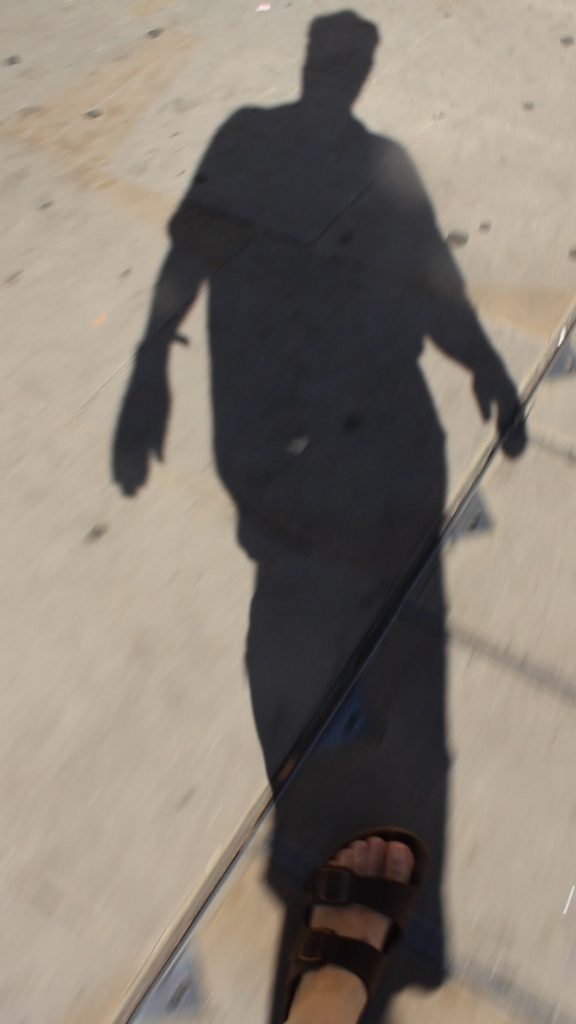Mark Wallinger, Shadow Walker
FEBRUARY 2021
Questions of identity occupy a central position in the oeuvre of the English artist Mark Wallinger (b. 1959). With his bold employment of a variety of techniques, Wallinger has explored the genre of the self-portrait of the artist in his paintings, his sculptures and his performances. The video installation Shadow Walker (2011) belongs to this continuum.
In the three-and-a-half-minute-long looped video, the artist walks along Shaftesbury Avenue in London. However, we don’t see the artist himself, only his shadow (the invisible camera is strung round Wallinger’s neck, and he manipulates it with his teeth using a kind of bit). In this way, the shadow becomes a double of the artist. Otherness in the self, a kind of doppelgänger theme, is an integral part of the work’s meaning. The second half of the German loan word in fact means ‘walker’.
To state the obvious, perhaps, the work is essentially about walking in a big city. In the context of art, this kind of behaviour has strong cultural roots. Paris in the 1830s gave birth to a character whom we have ever since known as a flâneur. This is a walker, sometimes also a stationary observer, absorbed in contemplating his surroundings, and his unhurried often pensive character has sometimes been misleadingly branded in dictionaries of foreign words as an ‘idler’. And in fact, in his earliest appearances, the flâneur did intentionally give the impression of indolence. In the course of time, however, this figure began to take on the character of a writer or artist examining and observing his surroundings. Charles Baudelaire, who explored the problematic nature of the flâneur, stated that his role was ‘to be at the centre of the world and yet to remain hidden from the world’.
There are also English models for the stroller in big cities, such as John Gay’s poem Trivia, or The Art of Walking the Streets of London (1716). The American writer Edgar Allan Poe’s famous story The Man of the Crowd (1840) is also situated in London. This character is like Wallinger’s shadow walker: ‘He is the man of the crowd’. It would be in vain to follow for I shall learn no more of him, nor of his deeds.’
Mark Wallinger’s shadow walker is not the impeccably dressed flâneur of the nineteenth century but an ordinary bloke dressed in Bermuda shorts and sandals. Although we do not encounter a hawk-eyed observer scrutinising the surrounding crowd but rather his opposite, one with his gaze fixed on the ground, he nevertheless offers the viewer an impression of the nature and special features of a big city. The noise of the traffic is strongly present as is the babble of the speech of multifarious people, and the hoardings of businesses abound.
Like a true flâneur, however, Shadow Walker focuses on details of the urban environment that easily go unnoticed by the ordinary passer-by. The viewer’s attention is drawn to details of the street, which itself becomes the subject of the work, the text, as often in the works of flaneur artists. In this case, Shaftesbury Avenue is presented directly as a concrete work of art. The grid theme of abstract and conceptual art here takes on numerous variations. The minimalism of various street pavings is emphasised by a few brightly coloured splashes: a daud of blue here, a dab of red there.
Nor is walking itself a subject that is unknown in art. Performances connected with walking can be found, for example, in the work of Richard Long (b. 1945) and Francis Alÿs (b. 1959). Also intimately connected with the artistic context of Shadow Walker are, for example, the shadow portraits taken of himself in an urban setting by Lee Friedlander (b. 1934), such as New York City (1965).
Mark Wallinger’s video installation Shadow Walker is a 21st-century flâneur’s view of the nature of the big city. While it activates associations with a long cultural tradition, it also offers a new and interesting perspective. The text of London is a noisy stream of consciousness packed with stimuli. Traces of the previous night’s orgiastic behaviour can still be discerned in the street. In the words of Baudelaire: ‘The pleasure which we derive from the representation of the present is due not only to the beauty with which it can be invested, but also to its essential quality of being present.’ On the other hand, one can also see in the fleeting moment a glimpse of something permanent, unchanging.
The early flâneur opposed the structures of capitalism although his indolence was enabled by them. So did the later flâneur, although he fashioned from his scrutinising a livelihood, a profession – from the practice of which in principle he should have been free. If Mark Wallinger’s Shadow Walker is seen as a self-portrait of the artist, it can also be viewed as a kind of shadow boxing by the flâneur artist, in which the consumer society that is the object of his criticism at the same time creates the prerequisites for his livelihood. This painful paradox follows the flâneur like a shadow.
Tomi Moisio
Curator
SOURCES
Baudelaire, Charles. ‘The Painter of Modern Life.’ In The Painter of Modern Life and Other Essays. Trans. Jonathon Mayne. 1995 (1863), London and New York: Phaedon Press.
Benjamin, Walter. ‘On Some Motifs in Baudelaire.’ Trans. Harry Zohn. In Illuminations; Essays and Reflections. Ed. Hannah Arendt , 1968 (1939), New York: Schocken.
Poe, Edgar Allan. ‘The Man of the Crowd.’ In The Complete Illustrated Works of Edgar Allan Poe. 2003 (1840), Chancellor Press.
Der Flaneur vom Impressionismus bis zur Gegenwart. Ed. Volker Adolphs & Stephan Berg. 2018, Kunstmuseum Bonn. Wienand.
Mark Wallinger Mark. Ed. Fiona Bradley. 2016, Serlachius Museums’ Publications 29.


